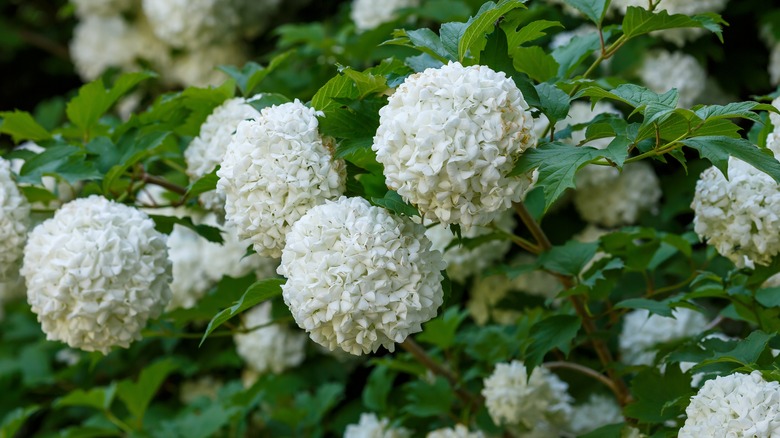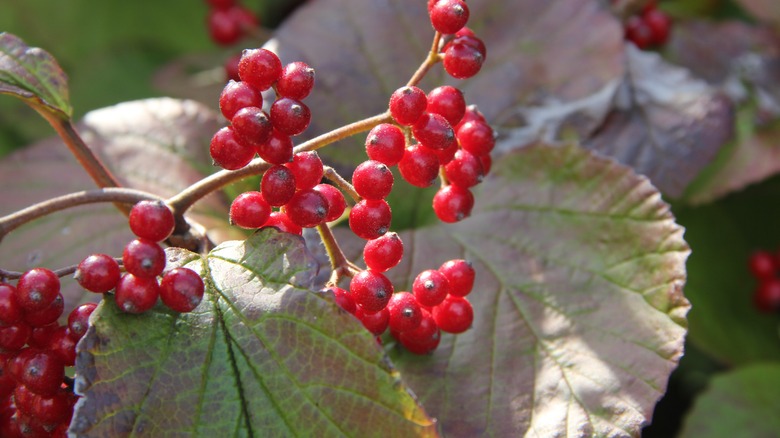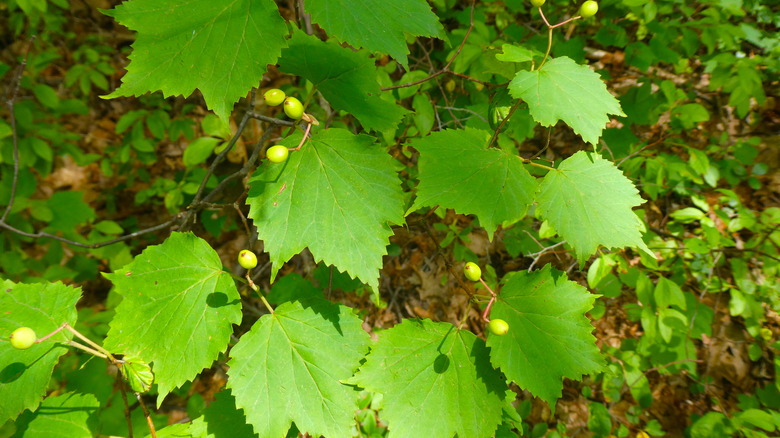Why You Should Reconsider Planting Viburnum In Your Yard, Despite Its Pretty Flowers
Viburnums are stunning shrubs, with many species in the genus boasting impressive flowers. Commonly mistaken for hydrangeas, these stunning plants are unsurprisingly ubiquitous in private gardens and public parks alike. Despite their beauty, not every viburnum species is the right choice for every region, and some are even invasive in many parts of North America. Luckily, there are also several native viburnum species available, so as long as you pick the right type of viburnum for your location, you can enjoy their beautiful blooms worry-free.
With over 150 species, gardeners considering adding one to their yard are truly spoiled for choice. Aside from North America, many are native to Asia, Europe, and Africa. While not all non-native plants are invasive, several, like Siebold's viburnum (Viburnum sieboldii), have become problems in the U.S. and Canada, where these plants escape from gardens and seize control of natural habitats. Because many of these invasive viburnums are still widely available for sale, it's essential to do your research and choose carefully when purchasing.
Viburnums to avoid in North America
There are several viburnum species that gardeners in North America should actively avoid. In addition to Siebold's viburnum, which is quickly becoming a problem in the Midwestern and Northeastern U.S. in particular, Linden viburnum (Viburnum dilatatum) is also quite invasive in many mid-Atlantic states thanks to how quickly it grows and its ability to form dense thickets. While both plants are beautiful and hugely appealing to birds and other wildlife, gardeners can achieve the same results with native or noninvasive species. Another viburnum that is sadly invasive in many areas is the stunning Japanese snowball (Viburnum plicatum) viburnum. Gardeners who want a plant with massive white balls of flowers, but without the Japanese snowball's invasive tendencies, should instead consider the Chinese snowball (Viburnum macrocephalum) which is strong in zones 6 through 9.
One somewhat confusing species of this undeniably beautiful plant is Viburnum opulus. While many of the different varieties in this species are native to North Europe and quite invasive in North America, one type, Viburnum opulus var. americanum, also known as highbush cranberry, is native to North America and thrives in zones 2 through 7. As its name suggests, this variety produces a delicious fruit similar to cranberries. Unfortunately, differentiating between the different types of Viburnum opulus can be quite challenging and because the different plants in the species can pollinate each other, many invasive hybrids have also formed.
Removing and replacing invasive viburnum
If you've discovered that the beautiful viburnum growing in your yard is invasive in your region, your best option is to immediately begin to safely remove the invasive plant species from your garden. If the plant is still small, you may be able to remove it by hand, simply by digging or pulling it up. For larger shrubs, though, you'll likely have to use herbicides to kill the plant and prevent it from re-growing once you've cut it back. While this may lead to a viburnum shaped hole in your heart and garden, there are plenty of native viburnums that can fill that space. From the maple leaf viburnum (Viburnum acerifolium) which prospers in zones 4 through 8 and seldom grows more than 6 feet tall and wide, to Walter's viburnum (Viburnum obovatum) which flourishes in zones 7 through 10 and can reach heights of 25 feet, there is an amazing amount of variety in North American viburnums.
If you are planting a rain garden, Witherod Viburnum (viburnum cassinoides) could be a perfect option thanks to its need for consistently moist soil, while gardeners in need of a drought tolerant plant might be better off going with its relative, downy arrowwood (Viburnum rafinesqueanum). The American highbush cranberry is also an excellent choice, as long as you're careful not to confuse it with its invasive European counterpart.


